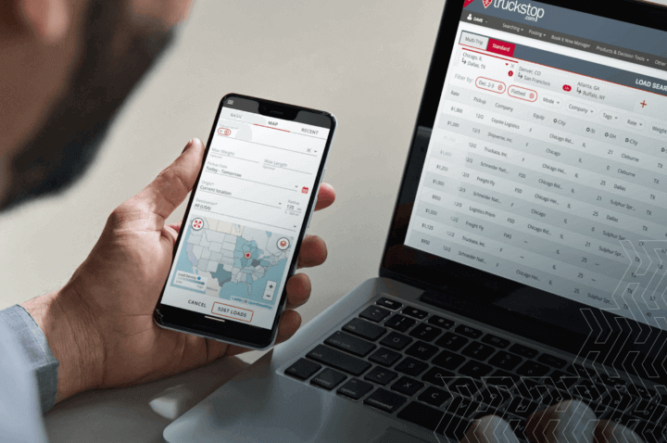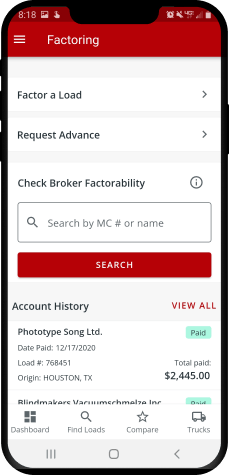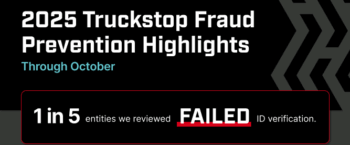Digital Freight Matching

What are you waiting for?
Make more money starting now.
No doubt you’ve heard the phrase “digital freight matching” or the “Uber-ization of freight.” Or maybe you’ve heard the term “on-demand” trucking.
Whatever people are calling it, it’s basically an easy button for the movement of freight in a world that demands products faster than ever. And it’s playing a major role in addressing today’s supply chain issues.
In today’s world of same day, next day, and two-day delivery, the need for a quick, efficient way to connect carriers with shippers and brokers is becoming more urgent. Every player in the transportation industry is currently staking a claim on what it is, what it means to them, and how they stand out from the competition in a sea of digital freight matching platforms.
What is digital freight matching?
Digital freight matching is the idea that a carrier can just tap and go, meaning the carrier taps to accept a load at a posted rate, and then they hit the road.
Behind what the driver sees, there is a shipper or broker posting the freight they need moved. In order for this idea of a digital freight matching easy button to work, load details must be included. Without knowing details like weight, rate, distance, and pick-up and delivery locations, a carrier can’t confidently commit to moving the load.
There’s a lot more that goes into making freight matching as simple as swiping left or right on a load.
The ideal digital freight matching experience predictively and proactively pushes matches to users, prioritizing users’ preferred business partners so they can work with people they prefer and trust. An efficient digital freight network can help brokers find carriers to meet capacity, keep carriers on the road and making money, and streamline shipping companies’ efforts to meet customer demand.
Digital freight matching vs. traditional 3PL
Traditionally, a 3PL (third-party logistics) provider offers outsourced services to help manage the complexities of procurement and fulfillment of goods. It generally applies to any service contract that involves shipping items. Typically, the 3PL entity takes responsibility for outsourcing the transportation of goods on behalf of the company shipping goods. This includes hiring a trucking carrier to haul the freight.
Traditional 3PLs use technology to match carrier capacity with freight. In that sense, a 3PL is a digital freight matcher. True digital freight matchers, however, take a technology-first approach, whereas 3PLs take a people-first approach. Digital freight matchers rely primarily on artificial intelligence (AI). 3PLs rely mainly on human interaction and expertise.
Digital freight matching centralizes the search for shipping solutions. Through a digital application or platform, mainly in the spot market vs. contract, carriers find the loads they need to fill their trucks, and shippers and brokers find available capacity that best fits their shipment. (In simplistic terms, it’s like a dating app for the freight world.)
Digital freight matching democratizes access to the best carriers, the best freight, and the best services. It’s a quick and efficient method of capacity fulfillment that can go beyond simple truck and load matching to offer other functionality, like rate insights for price negotiations, load tracking for visibility, and invoicing and other back-office necessities.
A digital freight network is an open, fully connected freight marketplace that uses software and technology to efficiently connect carriers, brokers, and shippers. As more freight professionals join the network, carriers have more load options to choose from so they can keep their trucks on the road and making money. They waste less time looking for loads. Conversely, brokers and shippers can find greater capacity faster, which lowers costs so they can increase profit margins.
A digital freight network automates the matching, pricing, and scheduling involved in the logistics of moving freight, reducing both the cost structure and the time it takes to move a load. It creates a domino effect of efficiencies, transparency, higher profits, and the ability to react and plan in real time for everyone involved in the moving of freight.
To sum it up, traditional 3PLs employ people that communicate directly to brokers, shippers, and carriers to carry out the tasks required to move a load. In digital freight matching, most transactions happen within the software application with minimal or no human-to-human contact.
How does digital freight matching work?
Digital freight matching is a software solution that uses machine learning, deep data, and advanced technology to help brokers, shippers, 3PLs and carriers find each other quickly to get a load moved safely to its destination. The broker or shipper user inputs a defined set of parameters into the system, including type of load, specific lane, pick-up and drop off dates and times, and cargo details. The software quickly identifies trucks and carriers that meet the specific requirements of that load. Matches are made in real time, dramatically faster than using manual methods, emails, and phone calls. Instead of hours, connections can happen in seconds and with a few mouse clicks.
Many digital freight matching platforms integrate right into a TMS, which gives users immediate access to all the functions they need to find and book loads right at their fingertips from a familiar workflow without ever switching from one system to another.
What are the benefits of digital freight matching?
Digital freight matching addresses some of the biggest pain points both carriers and brokers face during the negotiation process.
- No more “post and pray” approach to load and truck posting.
- Speeds up the time it takes to get a load covered.
- Reduces or eliminates time-consuming phone calls.
- Automates the entire process of finding qualified partners. Both carriers and brokers can be assured they’re working with reputable professionals.
- Eliminates manual process of faxing documents back and forth.
To solve for even more pain points, the ideal digital freight matching solution should:
- Provide digital messaging and paperwork, like invoices and contracts.
- Seamlessly connect partners.
- Provide insights that help carriers and brokers grow and profit.
- Provide a quick-pay option.
- Provide predictive matching to keep carriers loaded.
- Auto-match capacity to load for brokers.
- Integrate into the users’ TMS (transportation management system) or on any mobile device.
What to look for in a digital freight matching solution
While it’s true that today’s freight marketplace demands innovation and advanced technology solutions, make sure you choose a provider that supports you with easy access to human expertise. Truckstop delivers the best of both worlds: AI, machine learning, and the most robust data available, all wrapped up in an easy-to-use software solution. And it’s backed up by more than a quarter-century history of people who know the freight industry, plus a trained and responsive support team available to help you when you need it.
The platform you choose should have a high-volume network. Look for quality and quantity. On any given day, Truckstop posts up to half a million legitimate and unique loads. In fact, we have an entire team dedicated to keeping fraud and fraudulent players off the board. Plus, you won’t find duplicate loads. Our carrier network is among the largest in the industry, so you’ll always find the right carrier with the right equipment in the right lane, ready to move your freight.
Your digital freight matching solution should be easy to use and up and running when you need it. A glitchy or error-prone system will only lead to frustration when you’re trying to act fast and save time. Finding and posting loads should be a smooth process, plus you should be able to perform additional tasks beyond freight matching, like:
- Compare loads.
- Get rate data to aid in negotiations.
- Find the best-paying loads.
- Plan multiple trips.
- Choose the best partners to work with.
- Find the best fuel prices and keep fuel costs down.
- Book loads instantly.
The design and interface should be easy to navigate and intuitive to learn. Basically, think of it as a dashboard. Can you find everything you need quickly, and does it offer tools to help you navigate with ease to perform daily tasks?
Truckstop is on the forefront of digital freight matching.
Digital freight matching is being talked about in the transportation industry as a new concept, when the Truckstop Load Board has always provided the ability to connect brokers and carriers digitally. As with any other equivalent software or app, Truckstop users must input a certain amount of information to connect to the right broker or carrier. It’s the tap and go part of digital freight matching that’s relatively new (and a slight oversimplification).
Truckstop is entering this new era of freight matching by focusing on the opportunity to provide a single, seamless solution for freight matching.
Truckstop Load Board users already have access to a wide variety of features like rate tools, heat maps, and payment options (just to name a few), and we’re devoted to building and improving upon our suite of products with the end goal of providing a full-circle transportation software system for brokers and carriers. Toward that, the following solutions are part of our current offering:
RMIS Carrier Onboarding
In an age of nuclear verdicts that can destroy reputations and businesses in the freight industry, it’s critical that you know who’s behind the wheel of the loads you are moving. While the industry puts forth a set of hiring standards for carriers, they vary by state and can be inconsistent. Brokers and shippers should have their own carrier requirements that both meet national standards and help protect them from risk in the event a carrier that shouldn’t be on the road has a mishap with your shipment. Cargo can get lost and damaged, but worse yet, people can get injured and even killed.
Today’s digital freight matching solutions need a carrier compliance component that helps protect your business against risk and liability. That’s why Truckstop offers RMIS Carrier Onboarding, with access to the most extensive carrier database in the industry of more than 98% of active carriers. From your TMS, you can fast-track carrier hiring, whether you’re a shipper or a broker, and check their compliance status without spending hours or even days tracking down compliance paperwork. Our automated process is up to 80% faster than manual processes.
A branded carrier registration site makes carrier onboarding fast, easy, and paperless. You can customize it to your business rules, get daily updates and status alerts, and do all you can to ensure the carriers you hire and onboard are compliant every step of the way.
SaferWatch®
SaferWatch makes it fast and easy for brokers to find, verify, and monitor carriers throughout the lifecycle of their freight. Features and benefits include:
- Carrier sourcing. Search with automated selection rules and set risk assessment guidelines.
- Fast certificate of insurance acquisition. Access the largest database of carrier insurance certificates and request certificates in real time.
- See CSA-e percentile scores. Evaluate inspection and violation data to mitigate risk.
- Get TIA Watchdog reports. Identify fraud with validated carrier reviews.
- Ongoing compliance monitoring. Keep track of safety, insurance, and compliance for all your carriers.
Truckstop Factoring

Carriers can say good-bye to invoicing and cash flow worries by turning over time-consuming back-office paperwork to Truckstop Factoring. Carriers can focus on hauling freight—we’ll take care of the rest.
- Factor loads on the go with the mobile app.
- Easily apply for advances.
- Get instant broker credit checks.
- View your paid and unpaid load history.
- Scan your paperwork anytime, from anywhere.
Truckstop Book It Now

Our instant booking feature transforms the booking process from time-consuming phone calls and emails to a few simple clicks, to deliver speed, simplicity, and convenience. Brokers post rates up front, so carriers can see the rate before they book the load. This time-saving feature even allows carriers to book loads outside broker business hours, making the process more efficient for everyone. Brokers can cover more loads faster, carriers can book loads with trusted brokers from anywhere, anytime.
Stay tuned!
As one of first and most trusted load boards, Truckstop is leading the DFM revolution. Do business and stay connected in the palm of your hand via our app, Truckstop Go™. Because when it comes to helping all players in the freight industry keep pace and keep ahead of the curve, we won’t stop!
Get helpful content delivered to your inbox.
Sign up today.
Find high-quality loads fast, get higher rates on every haul, and access tools that make your job easier at every turn.






